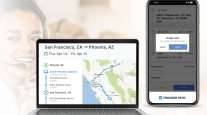Opinion: The Quest for Universal Freight Visibility
Asset tracking has always answered the question: “Where’s my truck?”
It still does, of course, but some cloud-based, third- party software providers now merge widely scattered tracking resources to provide unparalleled visibility for shippers, brokers, carriers and third-party logistics companies, or 3PLs.
This might seem like a small step, but it’s a big breakthrough in the long quest to control goods in motion and to fit freight transportation more precisely into the broader business of our nation — food, clothing, shelter, defense, etc. Now, a small group of software companies is edging ever closer to the holy grail of logistics: universal freight visibility.
The pursuit began with deregulation of trucking in 1980. Before then, most regulated common carriers offered both truckload and less-than-truckload services, using driver relays within their terminal networks. Except for private carriers and exempt freight — agricultural commodities, for example — long-distance trucking did not exist. Location updates were not a major concern.

A decisive first step was taken in 1983 when President Ronald Reagan made a version of the military Global Positioning System available for civilian use. The purposely fuzzy civilian version reported a truck’s approximate location. Greater precision would have to wait more than a decade, but this was a good start — particularly for the truckload sector. At least the GPS device in the truck could tell the driver where he was.
The next step was getting that location information from the GPS in the truck to fleet managers. Satellite companies were the first to commercially transmit GPS data from truck to office. Carriers that could afford it paid dearly to receive a couple of location updates a day — data they then could share with shippers by phone or EDI. It paid off. The carriers that made the investment grew more competitive.
In the 1990s, rapidly growing cellular networks became the preferred method for moving GPS data from truck to management. As wireless costs fell, frequent updates grew more affordable. At the same time, the new World Wide Web enabled carriers to share that information easily with customers who had only to log onto the carrier’s website.
Yet, for all the advances and lower costs, asset tracking and information sharing were used for the most part by big carriers with costly onboard telematics systems, and then only within their own systems for their own customers. So asset tracking grew slowly — at least until 2007, when the iPhone upended the business world.
The iPhone and the smartphones that followed it combined both GPS and the means to share data in a single, portable device. It was now possible to track any driver with a mobile phone, and thus to track his truck as well.
This was great news for brokers in particular. They already had access to tracking on some of the large carrier websites, but now they were finally able to track many of the drivers and small carriers with which they did business. Even though brokers still spent most of their time on phone calls with carriers and shippers, something like industrywide asset tracking was finally on the horizon.
Price was no longer an issue, but location data remained in separate silos sorted by carrier and platform. Your transportation management system, or TMS, software might get automatic updates from one or two big carriers, but not from the others. You had to go get it yourself, most often by lots of clicking to and through carrier websites. It took time and effort — less perhaps than phone calls — but time and effort nonetheless. If you used an assortment of carriers, such as big shippers — and many brokers do — it could easily amount to thousands of wasted man-hours per year.
Here is where the new technology comes in. Now we access GPS data from virtually every source — from satellite and cellular, proprietary platform and mobile phone, from telematics providers such as Omnitracs and PeopleNet as well as mobile networks such as Verizon and AT&T. We sort and aggregate that data by customer and deliver it in the most efficient way possible — through integration with a customer’s TMS or enterprise software, or on a browser page or dashboard.
Some providers offer more than just data. Their browser dashboards can enhance the data with real-time traffic and weather updates and adjust estimated times of arrival, or ETAs, accordingly. They can geofence pickup and delivery locations for automated arrival and departure alerts. They can track and evaluate carrier performance and apply predictive analytics to improve performance. In short, they offer virtually every advanced feature of the most expensive trucking platforms, but at a stunningly low cost.
With the imminent deployment of electric logging devices, or ELDs, in almost every heavy truck in the nation, the classic goal of universal visibility edges ever closer. When it finally arrives, a fair amount of credit will be due these entrepreneurial companies that saw a critical need and met it.
Elenjickal is the founder of logistics technology startup FourKites Inc., which is based in Chicago.




